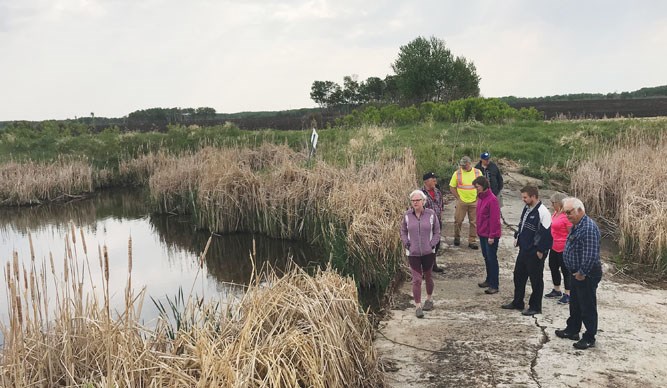In the winter of 2017 a regional, municipal drainage committee was struck among four municipalities to look beyond local concerns, bringing decision makers together on drainage issues.
Two councillors from each of the RMs of Yellowhead, Hamiota, Riverdale (Oak River area), and Wallace-Woodworth chaired by councillor Val Caldwell have formed the Regional Drainage Committee.
A couple of weeks ago, members of the committee had a joint tour “so the Northern RMs can see where all the water goes and get a better picture of how and who it impacts once it's left their borders,” said Caldwell.
Caldwell explained their purpose saying, “Our hope is that if big plans come forward such as increasing culvert sizes etc., each of the member RMs will consider and consult one another prior to taking action. So far, it's working very well.”
She noted that councillors from the north were surprised to see the impact drainage has by the time it reaches Wallace-Woodworth and Riverdale.
At present, sloughs, creeks and the Assiniboine River are at 30-year lows. But within the last decade infrastructure has been ruined by high water flows.
And, for over a decade, there have been concerns with the levels on Shoal Lake (RM of Yellowhead). A water consultant assures that recent plans to manage Shoal Lake’s levels and install three more culverts out of the south end of the lake (Arlington Beach) will not affect spring flow rates.
Drainage from the Shoal Lake area flows through the RMs of Hamiota, Wallace-Woodworth (east side) and on through Riverdale, where it meets up with the Assiniboine River.
The idea for a joint committee came to Caldwell twelve years ago.
“We had a situation a few years ago when Hamiota wanted to increase a culvert size, we opposed it, not because we didn’t want to see it happen, we wanted to see them considering downstream, first. So that included, at the time, Daly which is now Riverdale. …”
Manager of the Upper Assiniboine River Conservation District (UARCD) Ryan Canart was on the recent tour. He says, “As a CD, we love this idea. Let’s get together and manage this thing as a watershed. What I do up in Rossburn will affect Yellowhead, Hamiota, Wallace-Woodworth.…”
The UARCD is one of two CDs conducting pilot projects for the province.
“We would try to do some clean-out of old streams that aren’t working as well as they used to… and then try to find some retention close by to show that we can do efficient drainage and retention to mitigate downstream negative impact,” says Canart.
With a sizeable ravine running through their property east of Kenton, Caldwell knows the power of water firsthand. “It all comes pounding through our place.”
A retention pond in Caldwell’s ravine would fit with the provincial mandate to protect agriculture and wetlands without creating downstream problems says Canart.
Just a few years ago the repairs to the nearby road and to Brierwood Creek (downstream from Caldwell’s property) cost $1.2 million. Caldwell explains that a retention pond “would slow [the water] down before it gets to Brierwood Creek.”
The CD has a long history of working with farmers to everyone’s benefit. In dry years, like 2019 is turning out to be, the water retention provides a water source for livestock.
For farmers and property owners wanting to drain, or requesting a culvert, nothing has changed. People have to request a license from Manitoba Sustainable Development.
Even now, with licenses required for every piece of drainage, it is still difficult to regulate admits Caldwell.
“We hope that when ratepayers see their RMs working collaboratively and considering the impact on one another, that may encourage individual land owners to think the same way.
“There is no ‘my water, your water’. Water is everyone's issue,” Caldwell stated.




